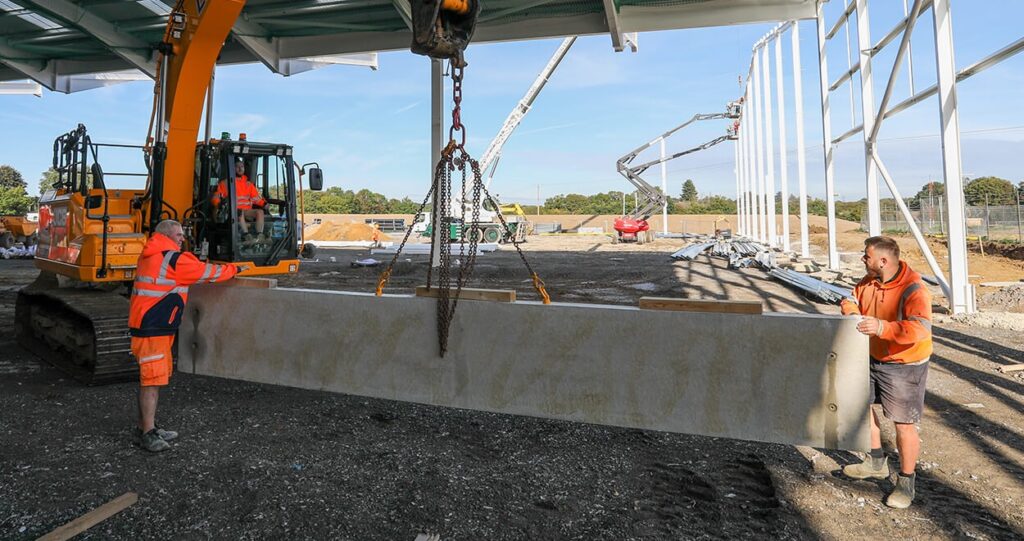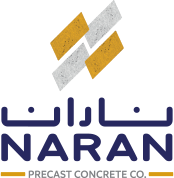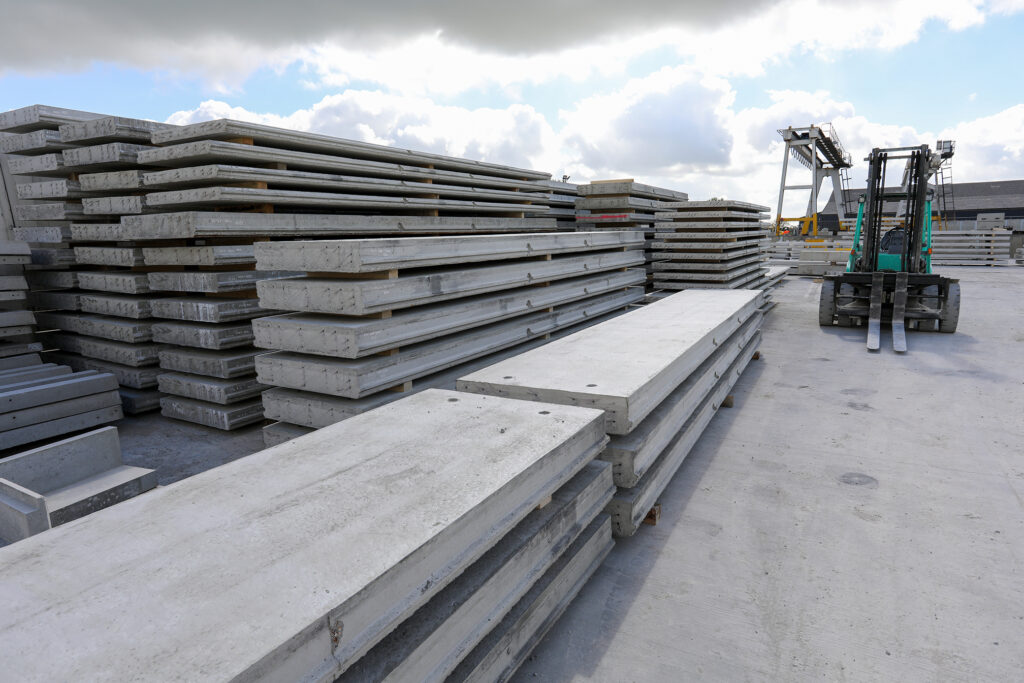Construction today runs on tight deadlines where every hour counts. To keep pace, the industry is turning to smarter, faster solutions. One of the most effective is precast concrete.
Shifting much of the work off-site, precast methods are helping projects move forward at record speed, cutting timelines in half while still maintaining quality and safety.
In this blog, we explain what precast concrete is, how it works, and why it makes construction faster, safer, and simpler.
What Is Precast Concrete?
Precast concrete refers to concrete elements that are cast and cured in a controlled factory environment, rather than poured and set on-site. These ready-made components, such as wall panels, beams, floors, and stairs, are transported to the construction site. Once there, they can be quickly assembled like building blocks, which makes the on-site work much faster and simpler.

This off-site manufacturing delivers uniform quality, precision, and durability, because the factory conditions allow for careful monitoring of materials, temperature, and curing times, all while saving time on the project schedule. Furthermore, precast elements can be customized in shape, size, and finish to meet specific design requirements, giving architects and builders more flexibility.
Why Precast Concrete Speeds Up Construction
Speed is the headline benefit of precast concrete. It comes from key procedural differences with traditional cast-in-place methods:
Parallel Workstreams
While the site is being prepared, precast parts are made in the factory at the same time. This means work happens in two places at once. As a result, the overall schedule is much shorter.
No On-site Curing Delays
Poured concrete needs to wait 28 days or more to become fully strong. However, precast units are already cured before leaving the factory. As a result, there is no long wait on-site. Construction can start right away.
Assembly-line Efficiency
Workers can put up many large components each day. As a result, the main structure is completed faster. This way, less manual labor is needed. Also, team coordination improves. In addition, it helps workers stay on schedule.
Weather-resilient Production
Because much fabrication is indoors, precast timelines don’t suffer from rain or harsh weather conditions. Construction delays from storms, extreme heat, or cold are reduced. As a result, schedules become more predictable.
Reduced Site Complexity
Less formwork, scaffolding, and material handling on-site means fewer delays. As a result, the site runs more smoothly. Fewer obstacles also lower the risk of accidents. In addition, logistics become simpler and easier to manage.
Real-World Time Savings
Case studies consistently show that precast concrete reduces construction duration by 50%, cutting weeks or even months off project deadlines. Typical examples include:
- Warehouses completed 3 weeks faster than conventional methods
- Office buildings erected in 4 weeks, compared to traditional 12 weeks
- Housing developments reaching weather-tight status in days, not weeks
- School expansions ready before new terms begin, ahead of cast-in-place schedules
Improved Quality and Reliability
Faster construction does not come at the cost of durability or strength. In fact, factory-controlled conditions often improve quality. The factory-controlled setting ensures strict quality assurance and consistent production. Precast components have very accurate dimensions. They also come with built-in insulation. This means there are fewer mistakes on site. Since they are made in a controlled factory, the risk of cracks, misalignment, or weak material is much lower.
Broader Time Savings Beyond Construction
Precast concrete also slashes time spent on project management tasks. Less waiting for inspections. Fewer alignment issues. Decreased paperwork. Accelerated regulatory approvals. Client acceptance. Additionally, faster assembly means teams can move to other projects sooner, maximizing productivity. The smooth workflow helps projects start earlier. This also brings a faster return on investment. Overall, less paperwork and a clear, predictable schedule make precast a good choice for developers and contractors.
Cost and Safety Benefits Aligned with Speed
Time savings translate directly into cost reductions. Shorter site occupation means lower labor, equipment hire, and overhead expenses. Moreover, because most work is moved from high-elevation or wet trades to safer factory floors, worker safety is enhanced. This lowers expensive accidents and insurance problems. At the same time, its speed, safety, and cost savings make precast concrete a smart choice for today’s construction projects.
Strategic Planning for Maximum Gains
To fully make the most of precast concrete’s time-saving benefits, early planning is essential:
- Finalize designs early to enable factory molds and batching.
- Secure factory production slots to align with site readiness.
- Ensure site access and foundations are prepared for swift installation.
- Coordinate lifting equipment and logistics for smooth delivery.
- Train construction teams on assembly sequencing.
Conclusion
Precast concrete is changing how fast buildings are made. It makes construction quicker, safer, and more organized. Making parts in a factory and then putting them together on-site helps projects finish much sooner than usual. This speeds up completion, helps teams work together better, lowers mistakes, and saves money. The substantial time saving helps businesses accelerate revenue, decrease risks, and improve overall project outcomes.
NaranPCC offers a range of precast structures, including precast panels, beams, and columns. They are constructed keeping in mind the best industry practices and design needs. Contact us to know how we can make a difference to your construction process.

